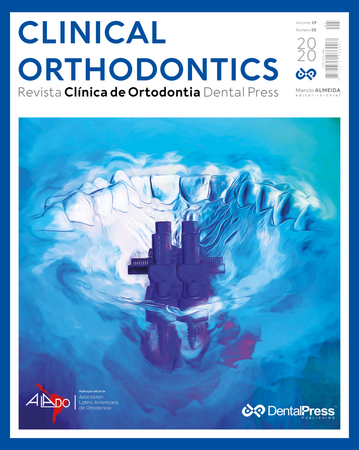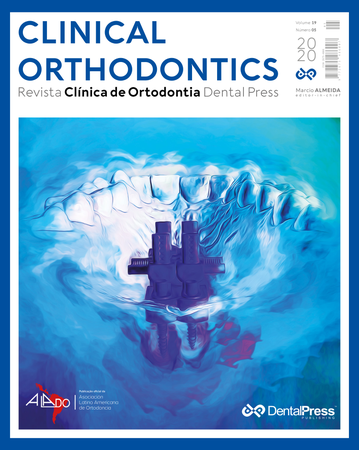Por onde começar um planejamento estético do sorriso?
Eu Penso Assim
INTRODUÇÃO: Embora existam inúmeras publicações sobre estética do sorriso, a realização dos planejamentos estéticos de forma simples e sistemática, ainda é um desafio. OBJETIVO: Apresentar um passo a passo sobre como começar um planejamento estético do sorriso e responder aos seguintes questionamentos: Por onde começar um planejamento estético do sorriso? Qual recurso pode ajudar na visualização dos problemas para elaborar o plano de tratamento e auxiliar na comunicação? RESULTADOS: O método apresentado foi empregado em dois casos clínicos que obtiveram ótimos...
Autores: André Wilson Machado,

“O grande líder é aquele que está disposto a desenvolver as pessoas até o ponto em que elas, eventualmente, o ultrapassem em seu conhecimento e habilidade.” (Fred A. Manske)
Leia mais
A primeira vez que assisti a uma apresentação do Dr. Sam Daher foi em um evento da Align em Las Vegas, há uns 10 ou 11 anos. Na ocasião, como Diretor Clínico da Align do Brasil, eu estava levando um grupo de doutores brasileiros ao Summit, um tradicional congresso da empresa que ocorria bianualmente. Surpreendi-me não só por sua experiência clínica com Invisalign, mas principalmente por suas colocações nos tratamentos com alinhadores, sempre se baseando em conceitos de Ortodontia...
Leia mais
INTRODUÇÃO: Na montagem do aparelho ortodôntico, existe uma variabilidade muito grande de acessórios, onde cada profissional escolhe os tubos e braquetes que melhor lhe servem, bem como o tipo de colagem que será feita. No entanto, embora existam inúmeras maneiras para se chegar a um resultado ótimo, uma das coisas que podem atrapalhar, principalmente as fases finais do tratamento, são os tubos dos molares. OBJETIVO: No presente trabalho, são demonstradas as diferenças entre os...
Leia mais
INTRODUÇÃO: Embora existam inúmeras publicações sobre estética do sorriso, a realização dos planejamentos estéticos de forma simples e sistemática, ainda é um desafio. OBJETIVO: Apresentar um passo a passo sobre como começar um planejamento estético do sorriso e responder aos seguintes questionamentos: Por onde começar um planejamento estético do sorriso? Qual recurso pode ajudar na visualização dos problemas para elaborar o plano de tratamento e auxiliar na comunicação?...
Leia mais
INTRODUÇÃO: A mecânica Tandem pode ser utilizada na Ortodontia para se obter alinhamento dos dentes sem sobrecarregar os braquetes e sua adesão. OBJETIVO: Descrever e explicar as vantagens de se aplicar a mecânica Tandem. CONCLUSÃO: A utilização de dois arcos de NiTi em Tandem pode trazer economias para o consultório, devido ao menor inventário, e também tratar os pacientes de braquetes autoligáveis sem sobrecarregar as portas ou a adesão dos braquetes.
Leia mais
INTRODUÇÃO: A Ortodontia digital trouxe muitos benefícios e alguns novos desafios. Um exemplo disso é o MARPE Guide, que tem vários pontos positivos já estabelecidos e alguns outros que necessitam ser evoluídos. OBJETIVO: O objetivo desta coluna é apresentar a evolução do MARPE Guide e os cuidados para se obter o máximo de precisão nos procedimentos que envolvem essa técnica. DESCRIÇÃO: Para realização do MARPE Guide, é necessário fazer a sobreposição do arquivo da...
Leia mais
OBJETIVO: Apresentar um sliding-jig apoiado em mini-implantes, com múltiplas funções. CONCLUSÃO: Com esse dispositivo, é possível otimizar o movimento ortodôntico, com um bom controle biomecânico.
Leia mais
INTRODUÇÃO: A correção da má oclusão de Classe II divisão 1 em pacientes com crescimento hiperdivergente e deficiência mandibular requer uma abordagem diferente dos tratamentos ortodônticos tradicionais, que não apresentam bons resultados. OBJETIVO: O presente artigo apresenta, por meio do relato de um caso clínico, uma sugestão de protocolo para corrigir esse tipo de deformidade dentofacial, associando a contenção do crescimento vertical da maxila com miniparafusos ao estímulo...
Leia mais
INTRODUÇÃO: As anomalias dentárias são um desafio a ser administrado pelos ortodontistas em um grande número de pacientes. Os dentes supranumerários correspondem a 8-9% das anomalias, e não parecem estar associados a outras alterações de forma, estrutura, tamanho ou posição. São de etiologia genético-ambiental ou causados por hiperatividade da lâmina dentária, geralmente de manifestação única e, quando múltiplos, estão comumente relacionados à disostose cleidocraniana,...
Leia mais
INTRODUÇÃO: A má oclusão de Classe II é muito comum, e, para se eleger o momento adequado para intervenção e selecionar o tipo de tratamento, diversos fatores devem ser levados em consideração. OBJETIVO: Relatar um caso de tratamento ortodôntico de uma paciente com 9 anos de idade e má oclusão de Classe II, divisão 2 de Angle, com protrusão maxilar e ausência de espaços para a erupção dos caninos superiores permanentes. RELATO DO CASO: Como a família recusou a cirurgia...
Leia mais
OBJETIVO: O presente artigo tem como objetivo descrever as etapas do Protocolo Alt-RAMEC modificado para a correção precoce da má oclusão de Classe III, bem como apresentar um caso tratado pela técnica proposta. O Protocolo é indicado para pacientes com Classe III esquelética, por deficiência maxilar, em dentição decídua, mista ou permanente jovem. MÉTODOS: Após a cimentação do Disjuntor DAFI (Disjuntor de Abertura e Fechamento Itaborahy) nos molares superiores, inicia-se a...
Leia mais
OBJETIVO: O objetivo do presente estudo foi comparar as alterações cefalométricas associadas ao tratamento ortodôntico compensatório da má oclusão esquelética de Classe III. MÉTODOS: Estudo clínico retrospectivo realizado com 72 cefalogramas de 36 pacientes com má oclusão de Classe III esquelética e idade média de 22,9 anos (desvio-padrão 1,57 anos). O estudo incluiu pacientes com sobressaliência negativa, ângulo ANB < 0° e Wits < -1 mm. Todos os pacientes foram...
Leia mais
OBJETIVO: Apresentar uma lista de checagem de condutas para se prevenir das reabsorções dentárias no tratamento ortodôntico, visto que elas são previsíveis. RESULTADO: A lista apresentada de 20 fatores preditivos ajuda a contornar, ou controlar, as reabsorções dentárias nos casos clínicos ortodônticos, devendo ser coletada e analisada desde a primeira consulta do paciente, mesmo ainda sem a documentação composta pelos exames complementares. CONCLUSÃO: Nesses casos e situações de...
Leia mais
INTRODUÇÃO: A fratura condilar mandibular está entre as fraturas maxilofaciais mais frequentes. Entretanto, o tratamento das fraturas dos côndilos continua sendo uma questão controversa. Os argumentos se concentram no que se refere ao tratamento cirúrgico aberto versus o tratamento conservador fechado. OBJETIVO: O presente artigo relata o caso clínico de uma paciente jovem que apresentava uma má oclusão de Classe I de Angle, com fratura e alteração morfológica do côndilo...
Leia mais
In a world that has been plagued by one of theworst pandemics ever seen before, that of Covid-19, questions remain despite its unfolding, bothpolitically and economically and socially. Theworld is currently experiencing, at least at thepolitical level, a dichotomous clash betweenthe population and its leaders. The lockdownestablished in some places in the world does not seem to have worked as it should, in order toprovide control of the spread of the coronavirus.Our leaders seem to be absent...
Leia mais
The first time I attended a performance by Dr. Sam Daher wasat an Align event in Las Vegas, about 10 or 11 years ago. At thetime, as Clinical Director of Brazil’s Align, I was taking a groupof Brazilian doctors to the Summit, a traditional congress ofthe company that took place biannually. I was surprised notonly by his clinical experience with Invisalign, but mainly byhis considerations in treatments with aligners, always basedon concepts of conventional orthodontics — yes, the...
Leia mais
INTRODUCTION: When assembling theorthodontic appliance there is a great variabilityof accessories. Each professionalchooses the most appropriate tubes andbrackets, as well as the type of bonding.However, although there are countlessways to achieve optimal results, one of thethings that can get in the way, especially inthe final stages of treatment, are the molar tubes.OBJECTIVE: In this study the differences betweensimple and convertible tubes will be demonstrated, aswell as their...
Leia mais
INTRODUCTION: Althoughthere are numerous publicationson smile esthetics, therealization of esthetic treatmentplanning in a simpleand systematic way is still achallenge. OBJECTIVE: To presenta step-by-step method on howto start an esthetic smile planningand answer the following questions:Where to start a treatment planning focusingon smile esthetics? Which resource can help in visualizingthe problems to develop the treatment planningand assist in communication? RESULTS: OThe methodpresented...
Leia mais
INTRODUCTION: Tandemmechanics canbe used in orthodonticsto achieve toothalignment withoutoverloading the bracketsand their adhesion.OBJECTIVE: To describeand explain the advantagesof applying Tandem mechanics.CONCLUSION: The use of two NiTi arches in Tandemcan be cost-effective for the office, due to the reducedinventory, and can also treat patients with self-ligatingbrackets without overloading the doors or the bracketsadherence.
Leia mais
INTRODUCTION: Digital orthodonticshas brought many benefits and some newchallenges, one example is the MARPE guide, whichhas several positive points already established andsome others that need to be evolved. The purpose ofthis paper is to present the evolution of MARPE guideand the precautions to obtain maximum precision inthe procedures involving this technique. DESCRIPTION:To produce a MARPE guide it is necessaryto superimpose the tomography file and the intraoralscan file, to allow the...
Leia mais
OBJECTIVE: The purpose of this paper is to presenta sliding jig with multiple functions. CONCLUSION:With this device it is possible to obtain optimizationof the orthodontic movement with a good biomechanicalcontrol.
Leia mais
INTRODUCTION: The correction of Class II division1 malocclusion in patients with hyperdivergent growthpattern and mandibular retrognathism requires a differentapproach from the traditional treatment, which usually doesnot provide good results. OBJECTIVE: This article presentsa case report to illustrate an alternative protocol to correctthis type of dentofacial deformity, using the associationof miniscrews to restrain the maxillary vertical growthand a mandibular advancement appliance, to...
Leia mais
INTRODUCTION: Dental anomalies are challenges thatorthodontists may have to face when treating severalpatients. Supernumerary teeth, which represent about8-9% of all anomalies, do not seem to be associated withother shape, structure, size or position abnormalities.They have genetic-environmental causes, but may alsoresult from a hyperactive dental lamina, affecting onlyone tooth or, when more than one, usually associatedwith cleidocranial dysostosis, Gardner syndrome or cleftlip and palate....
Leia mais
INTRODUCTION: Class II malocclusion is a common condition,and several factors are considered when choosingthe appropriate time for intervention and selecting the typeof treatment. METHODS: This case report describes theorthodontic treatment of a 9-year-old patient with AngleClass II, Division 2 malocclusion, with maxillary protrusionand, insufficient spaces for the eruption of the permanentmaxillary canines. Since the patient’s family opted outorthognathic surgery and facial profile, the...
Leia mais
INTRODUCTION: This paper aims to describe the stepsof the Modified Alt RAMEC Protocol for early correctionof Class III malocclusion, as well as to present acase treated by the proposed technique. The protocolis indicated for patients with skeletal Class III, due tomaxillary deficiency, in deciduous, mixed or young permanentdentition. METHODS: After cementing the DAFIexpander (Itaborahy opening and closing expander) onthe upper molars, the activation/deactivation phase of theexpander is...
Leia mais
OBJECTIVE: The aim of this study was to compare thecephalometric changes associated with the compensatorytreatment of skeletal Class III malocclusionpatients treatedwith anterior maxillary and mandibular torque alterations.METHODS: The sample consisted of 72 lateral cephalogramsof 36 patients treated with Class III Biofunctional brackets,with programmed modified torque on the maxillary (centraland lateral: 0o) and mandibular (central and lateral: +10o)incisors, with a mean age of 22.9 years...
Leia mais
OBJECTIVE: To present a checklist of conducts to preventtooth resorption in orthodontic treatment, sincethey are predictable. RESULT: The list of 20 predictivefactors presented will help to avoid or control toothresorption in orthodontic clinical cases, and data mustbe collected and analyzed right from the patient’s firstconsultation, even without the documentation composedof the complementary exams. CONCLUSION:In these cases, and situations with full informationand knowledge, the...
Leia mais
INTRODUCTION: Mandibular condylar fracture is oneof the most frequent fracture of the facial skeleton.However, the treatment of this condition remains acontroversial issue. The arguments were about an opensurgical treatment approach a versus conservativetreatment. OBJECTIVE: The present article reports ayoung patient who presented a Class I malocclusion,fracture of the right condyle with morphological alteration,bone asymmetry and mandibular deviation. CASEREPORT: The interdisciplinary...
Leia maisCopyright © 1998 - 2022 DentalGO | Todos Direitos Reservados. DentalGO é uma marca Dental Press